Long Persistent Luminescent HDPE Composites with Strontium Aluminate and Their Phosphorescence, Thermal, Mechanical, and Rheological Characteristics
Abstract
:1. Introduction
2. Materials and Methods
2.1. Materials
2.2. Methods
2.2.1. Composites Preparation
2.2.2. Composites Characterization
2.2.3. Phosphorescence Intensity vs. Time in HDPE/AG1 and HDPE/AG2 Composites
2.2.4. Effect of Ageing on Phosphorescence and Mechanical Properties
3. Results and Discussion
3.1. Particles and Composites SEM Analysis
3.2. DSC and FTIR Data for HDPE/AG1 and HDPE/AG2 Composites
3.3. Mechanical Characterization of HDPE/AG1 and HDPE/AG2
3.4. Rheological Studies in HDPE/AG1 and HDPE/AG2 Composites
3.5. Phosphorescence Studies in HDPE/AG1 and HDPE/AG2 Composites
3.6. Phosphorescence Intensity Decay Studies in HDPE/AG1 and HDPE/AG2 Composites
3.7. Effect of Ageing on Phosphorescence and Mechanical Properties
4. Conclusions
Author Contributions
Funding
Institutional Review Board Statement
Informed Consent Statement
Data Availability Statement
Acknowledgments
Conflicts of Interest
References
- Hölsä, J. Persistent luminescence beats the afterglow: 400 years of persistent luminescence. Electrochem. Soc. Interface 2009, 18, 42. [Google Scholar] [CrossRef]
- Harvey, E.N. A History of Luminescence from the Earliest Times until 1900; American Philosophical Society: Philadelphia, PA, USA, 1957; pp. 1–677. [Google Scholar]
- Abbruscato, V. Optical and Electrical Properties of SrAl2O4: Eu2+. J. Electrochem. Soc. 1971, 118, 930. [Google Scholar] [CrossRef]
- Katsumata, T.; Sasajima, K.; Nabae, T.; Komuro, S.; Morikawa, T. Characteristics of strontium aluminate crystals used for long-duration phosphors. J. Am. Ceram. Soc. 1998, 81, 413–416. [Google Scholar] [CrossRef]
- Katsumata, T.; Nabae, T.; Sasajima, K.; Komuro, S.; Morikawa, T. Effects of Composition on the Long Phosphorescent SrAl2O4: Eu2+, Dy3+ Phosphor Crystals. J. Electrochem. Soc. 1997, 144, L243. [Google Scholar] [CrossRef]
- Nance, J.; Sparks, T.D. From streetlights to phosphors: A review on the visibility of roadway markings. Prog. Org. Coat. 2020, 148, 105749. [Google Scholar] [CrossRef]
- Nance, J.; Sparks, T.D. Comparison of coatings for SrAl2O4: Eu2+, Dy3+ powder in waterborne road striping paint under wet conditions. Prog. Org. Coat. 2020, 144, 105637. [Google Scholar] [CrossRef]
- Lin, Y.-C.; Karlsson, M.; Bettinelli, M. Inorganic phosphor materials for lighting. Top. Curr. Chem. 2016, 374, 21. [Google Scholar] [CrossRef] [Green Version]
- Tan, H.; Wang, T.; Shao, Y.; Yu, C.; Hu, L. Crucial breakthrough of functional persistent luminescence materials for biomedical and information technological applications. Front. Chem. 2019, 7, 387. [Google Scholar] [CrossRef]
- Wang, W.; Sha, A.; Lu, Z.; Yuan, D.; Jiang, W.; Liu, Z. Cement filled with phosphorescent materials for pavement: Afterglow decay mechanism and properties. Constr. Build. Mater. 2021, 284, 122798. [Google Scholar] [CrossRef]
- Maldiney, T.; Richard, C.; Seguin, J.; Wattier, N.; Bessodes, M.; Scherman, D. Effect of Core Diameter, Surface Coating, and PEG Chain Length on the Biodistribution of Persistent Luminescence Nanoparticles in Mice. ACS Nano 2011, 5, 854–862. [Google Scholar] [CrossRef]
- Paterson, A.S.; Raja, B.; Garvey, G.; Kolhatkar, A.; Hagström, A.E.; Kourentzi, K.; Lee, T.R.; Willson, R.C. Persistent luminescence strontium aluminate nanoparticles as reporters in lateral flow assays. Anal. Chem. 2014, 86, 9481–9488. [Google Scholar] [CrossRef] [Green Version]
- Chen, W.; Wang, Y.; Zeng, W.; Han, S.; Li, G.; Guo, H.; Li, Y.; Qiang, Q. Long persistent composite phosphor CaAl2O4: Eu2+, Nd3+/Y3 Al5 O12: Ce3+: A novel strategy to tune the colors of persistent luminescence. New J. Chem. 2016, 40, 485–491. [Google Scholar] [CrossRef]
- Zheng, R.; Xu, L.; Qin, W.; Chen, J.; Dong, B.; Zhang, L.; Song, H. Electrospinning preparation and photoluminescence properties of SrAl2O4: Ce3+ nanowires. J. Mater. Sci. 2011, 46, 7517–7524. [Google Scholar] [CrossRef]
- Sakirzanovas, S.; Katelnikovas, A.; Dutczak, D.; Kareiva, A.; Jüstel, T. Synthesis and Sm2+/Sm3+ doping effects on photoluminescence properties of Sr4Al14O25. J. Lumin. 2011, 131, 2255–2262. [Google Scholar] [CrossRef]
- Feng, X.; Feng, W.; Wang, K. Experimental and theoretical spectroscopic study of praseodymium (III) doped strontium aluminate phosphors. J. Alloy. Compd. 2015, 628, 343–346. [Google Scholar] [CrossRef]
- Lupei, A.; Lupei, V.; Gheorghe, C.; Gheorghe, L.; Vivien, D.; Aka, G.; Antic-Fidancev, E. Disorder effects in Nd3+-doped strontium hexa-aluminate laser crystals. J. Phys. Condens. Matter 2005, 18, 597–611. [Google Scholar] [CrossRef]
- Lu, B.; Shi, M.; Pang, Z.; Zhu, Y.; Li, Y. Study on the optical performance of red-emitting phosphor: SrAl2O4: Eu2+, Dy3+/Sr2MgSi2O7: Eu2+, Dy3+/light conversion agent for long-lasting luminous fibers. J. Mater. Sci. Mater. Electron. 2021, 1–13. [Google Scholar] [CrossRef]
- Sahu, I.P.; Bisen, D.; Sharma, R. UV excited green luminescence of SrAl2O4: Eu2+, Dy3+ nanophosphor. Res. Chem. Intermed. 2016, 42, 2791–2804. [Google Scholar] [CrossRef]
- Chang, C.-C.; Yang, C.-Y.; Lu, C.-H. Preparation and photoluminescence properties of Sr4Al14O25:Eu2+ phosphors synthesized via the microemulsion route. J. Mater. Sci. Mater. Electron. 2013, 24, 1458–1462. [Google Scholar] [CrossRef]
- Zhu, Y.; Zeng, J.; Li, W.; Xu, L.; Guan, Q.; Liu, Y. Encapsulation of strontium aluminate phosphors to enhance water resistance and luminescence. Appl. Surf. Sci. 2009, 255, 7580–7585. [Google Scholar] [CrossRef]
- Lü, X.; Zhong, M.; Shu, W.; Yu, Q.; Xiong, X.; Wang, R. Alumina encapsulated SrAl2O4:Eu2+, Dy3+ phosphors. Powder Technol. 2007, 177, 83–86. [Google Scholar] [CrossRef]
- Tian, S.; Wen, J.; Fan, H.; Chen, Y.; Yan, J.; Zhang, P. Sunlight-activated long persistent luminescent polyurethane incorporated with amino-functionalized SrAl2O4:Eu2+, Dy3+phosphor. Polym. Int. 2016, 65, 1238–1244. [Google Scholar] [CrossRef]
- Oguzlar, S.; Ongun, M.Z.; Keskin, O.Y.; Delice, T.K.; Azem, F.A.; Birlik, I.; Ertekin, K. Investigation of Spectral Interactions between a SrAl2O4: Eu2+, Dy3+ Phosphor and Nano-Scale TiO2. J. Fluoresc. 2020, 30, 839–847. [Google Scholar] [CrossRef] [PubMed]
- Khattab, T.A.; Abd El-Aziz, M.; Abdelrahman, M.S.; El-Zawahry, M.; Kamel, S. Development of long-persistent photoluminescent epoxy resin immobilized with europium (II)-doped strontium aluminate. Luminescence 2020, 35, 478–485. [Google Scholar] [CrossRef] [PubMed]
- Wan, M.; Jiang, X.; Nie, J.; Cao, Q.; Zheng, W.; Dong, X.; Fan, Z.H.; Zhou, W. Phosphor powders-incorporated polylactic acid polymeric composite used as 3D printing filaments with green luminescence properties. J. Appl. Polym. Sci. 2019, 137, 48644. [Google Scholar] [CrossRef]
- Cheng, L.-X.; Liu, T.; Li, L.; Yang, L.; He, H.-W.; Zhang, J.-C. Self-repairing inorganic phosphors/polymer composite film for restructuring luminescent patterns. Mater. Res. Express 2021, 8, 065302. [Google Scholar] [CrossRef]
- De Clercq, D.M.; Chan, S.V.; Hardy, J.; Price, M.B.; Davis, N.J.L.K. Reducing reabsorption in luminescent solar concentrators with a self-assembling polymer matrix. J. Lumin. 2021, 236, 118095. [Google Scholar] [CrossRef]
- Poulose, A.M.; Anis, A.; Shaikh, H.; Alhamidi, A.; Siva Kumar, N.; Elnour, A.Y.; Al-Zahrani, S.M. Strontium Aluminate-Based Long Afterglow PP Composites: Phosphorescence, Thermal, and Mechanical Characteristics. Polymers 2021, 13, 1373. [Google Scholar] [CrossRef]
- Ye, F.; Dong, S.; Tian, Z.; Yao, S.; Zhou, Z.; Wang, S. Fabrication and characterization of long-persistent luminescence/polymer (Ca2MgSi2O7: Eu2+, Dy3+/PLA) composite fibers by electrospinning. Opt. Mater. 2015, 45, 64–68. [Google Scholar] [CrossRef]
- Khursheed, S.; Kumar, V.; Singh, V.K.; Sharma, J.; Swart, H. Optical properties of Sr3B2O6: Dy3+/PMMA polymer nanocomposites. Phys. B Condens. Matter 2018, 535, 184–188. [Google Scholar] [CrossRef]
- George, G.; Luo, Z. A Review on Electrospun Luminescent Nanofibers: Photoluminescence Characteristics and Potential Applications. Curr. Nanosci. 2020, 16, 321–362. [Google Scholar] [CrossRef]
- Bem, D.; Swart, H.; Luyt, A.; Coetzee, E.; Dejene, F. Properties of green SrAl2O4 phosphor in LDPE and PMMA polymers. J. Appl. Polym. Sci. 2010, 117, 2635–2640. [Google Scholar] [CrossRef]
- Ni, Z.; Fan, T.; Bai, S.; Zhou, S.; Lv, Y.; Ni, Y.; Xu, B. Effect of the Concentration of SrAl2O4: Eu2+and Dy3+ (SAO) on Characteristics and Properties of Environment Friendly Long-Persistent Luminescence Composites from Polylactic Acid and SAO. Scanning 2021, 2021, 6337768. [Google Scholar] [CrossRef] [PubMed]
- Włochowicz, A.; Eder, M. Distribution of lamella thicknesses in isothermally crystallized polypropylene and polyethylene by differential scanning calorimetry. Polymer 1984, 25, 1268–1270. [Google Scholar] [CrossRef]
- Ouchiar, S.; Stoclet, G.G.; Cabaret, C.; Gloaguen, V. Influence of the filler nature on the crystalline structure of polylactide-based nanocomposites: New insights into the nucleating effect. Macromolecules 2016, 49, 2782–2790. [Google Scholar] [CrossRef]
- Xu, J.; Tanabe, S. Persistent luminescence instead of phosphorescence: History, mechanism, and perspective. J. Lumin. 2019, 205, 581–620. [Google Scholar] [CrossRef]
- Clabau, F.; Rocquefelte, X.; Jobic, S.; Deniard, P.; Whangbo, M.-H.; Garcia, A.; Le Mercier, T. Mechanism of phosphorescence appropriate for the long-lasting phosphors Eu2+-doped SrAl2O4 with codopants Dy3+ and B3+. Chem. Mater. 2005, 17, 3904–3912. [Google Scholar] [CrossRef]
- Dorenbos, P. Mechanism of persistent luminescence in Eu2+ and Dy3+ codoped aluminate and silicate compounds. J. Electrochem. Soc. 2005, 152, H107–H110. [Google Scholar] [CrossRef] [Green Version]
- Lephoto, M.A.; Ntwaeaborwa, O.M.; Pitale, S.S.; Swart, H.C.; Botha, J.R.; Mothudi, B.M. Synthesis and characterization of BaAl2O4:Eu2+ co-doped with different rare earth ions. Phys. B Condens. Matter 2012, 407, 1603–1606. [Google Scholar] [CrossRef]
- Kim, S.; Lee, Y.; Kim, C.; Choi, S. Analysis of Mechanical Property Degradation of Outdoor Weather-Exposed Polymers. Polymers 2022, 14, 357. [Google Scholar] [CrossRef]
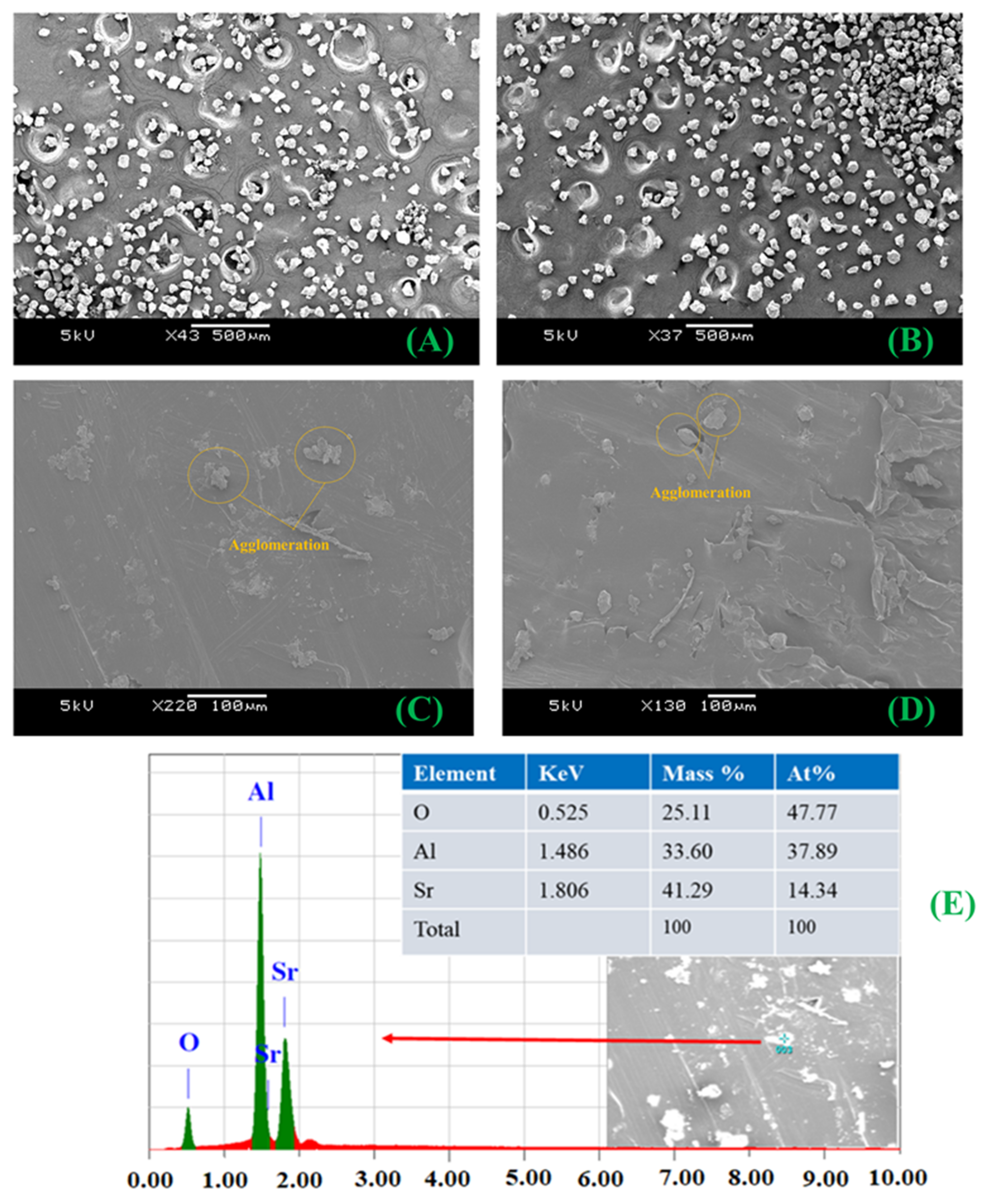

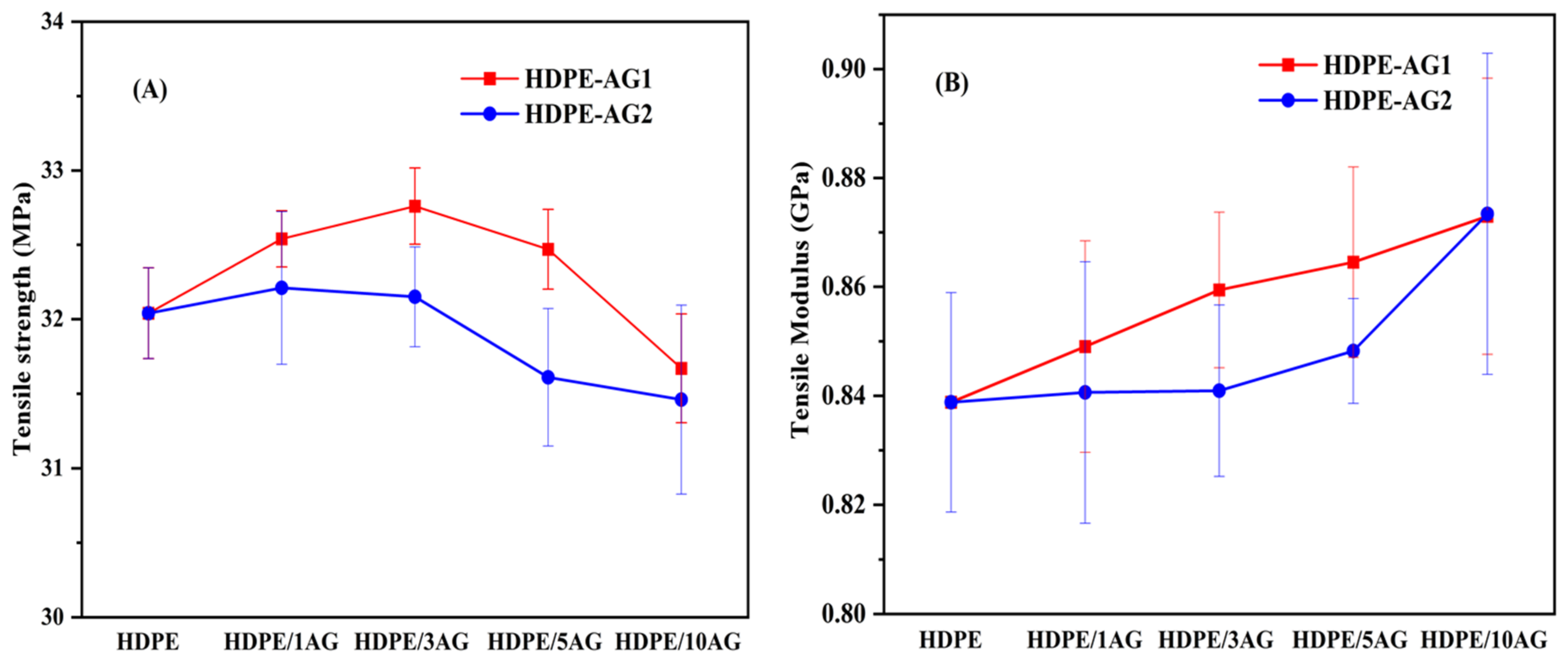
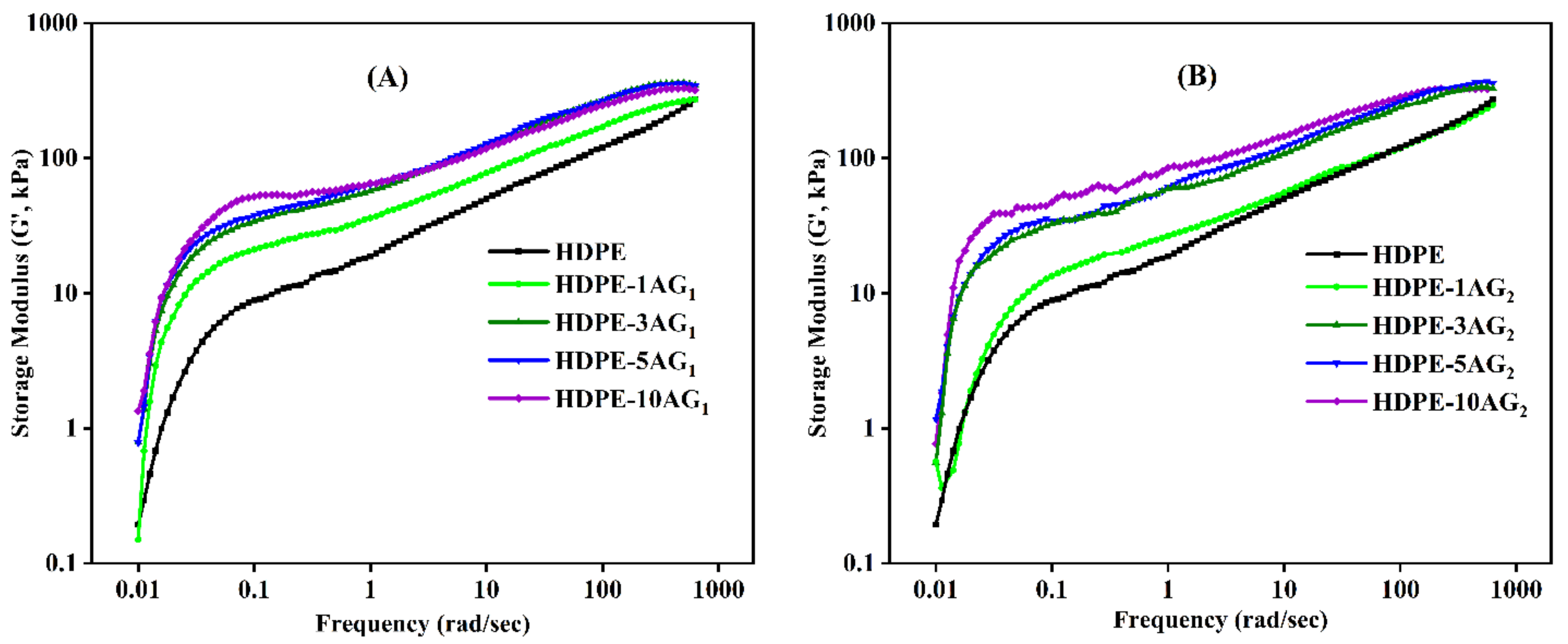


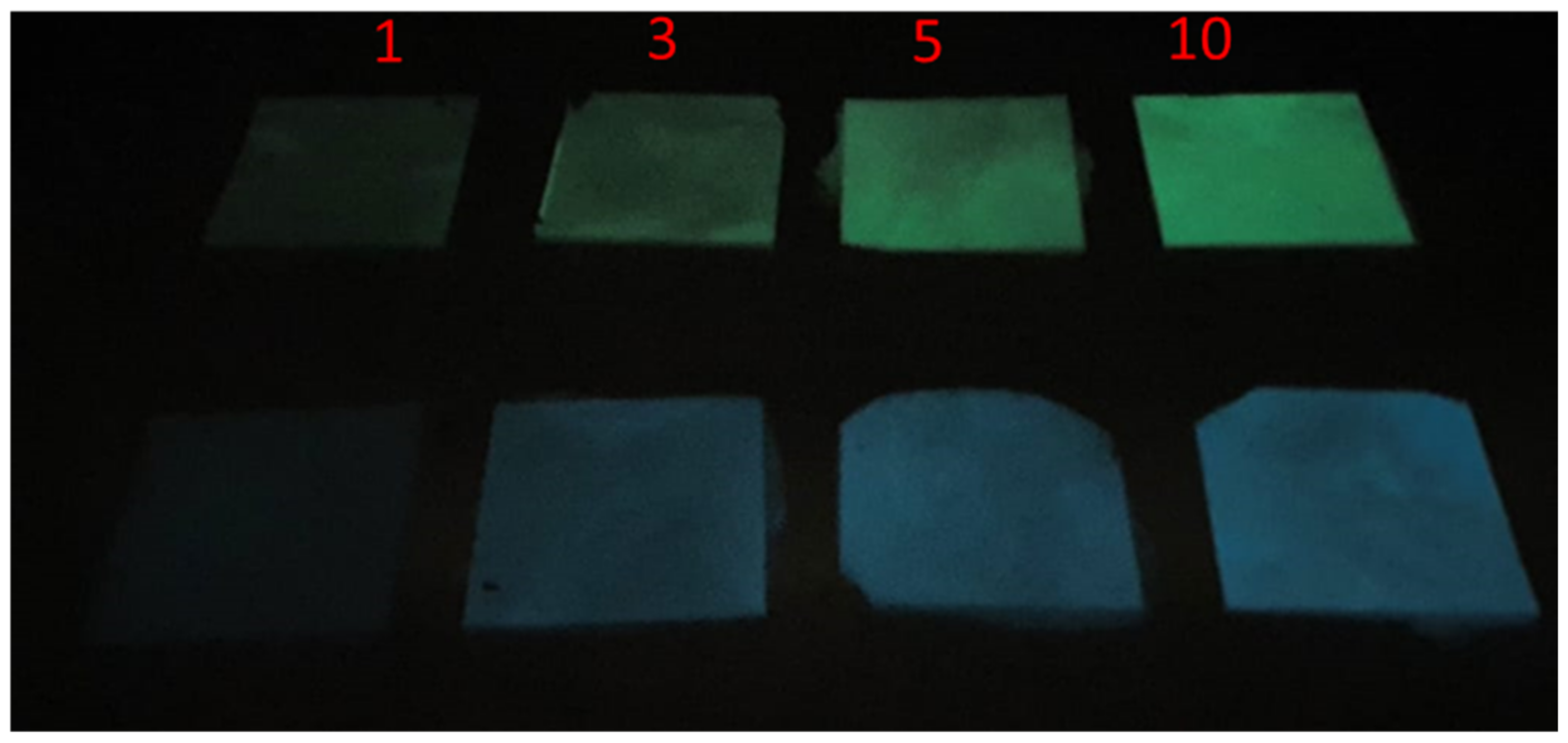
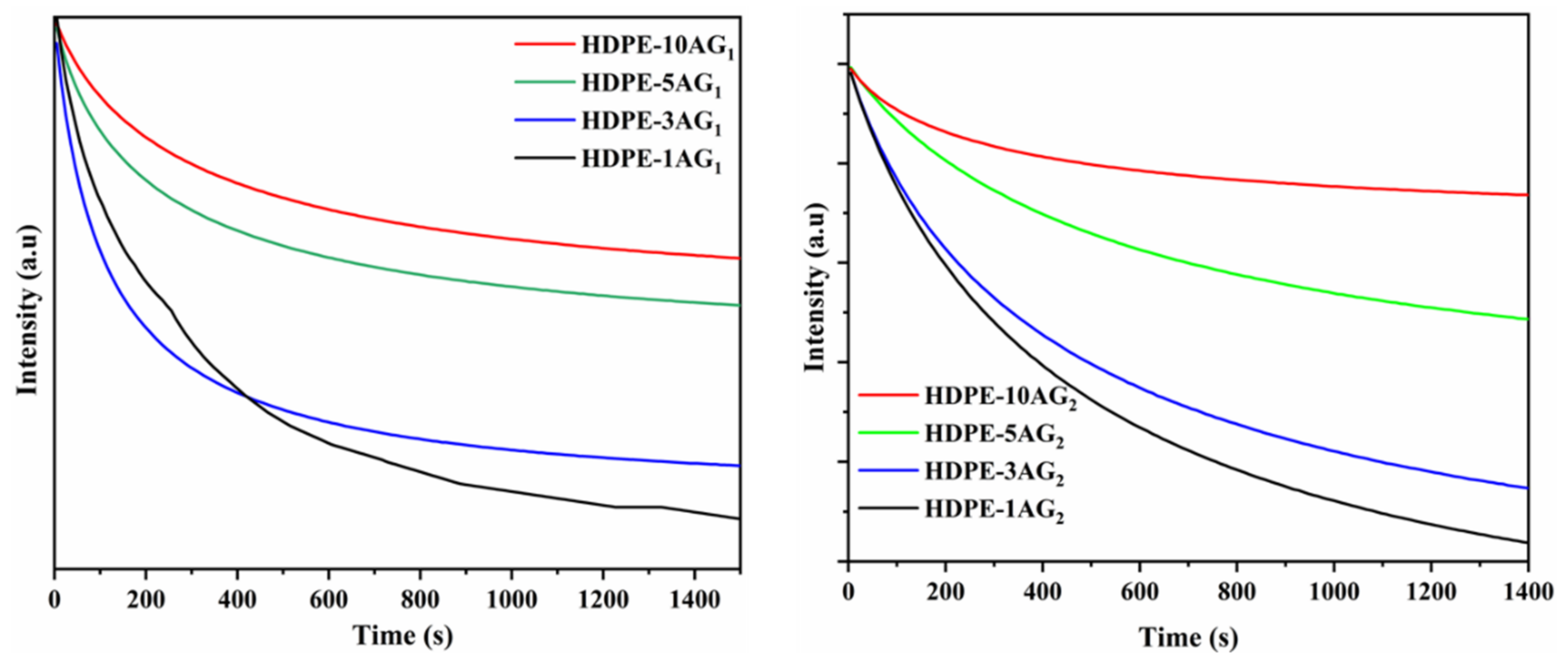
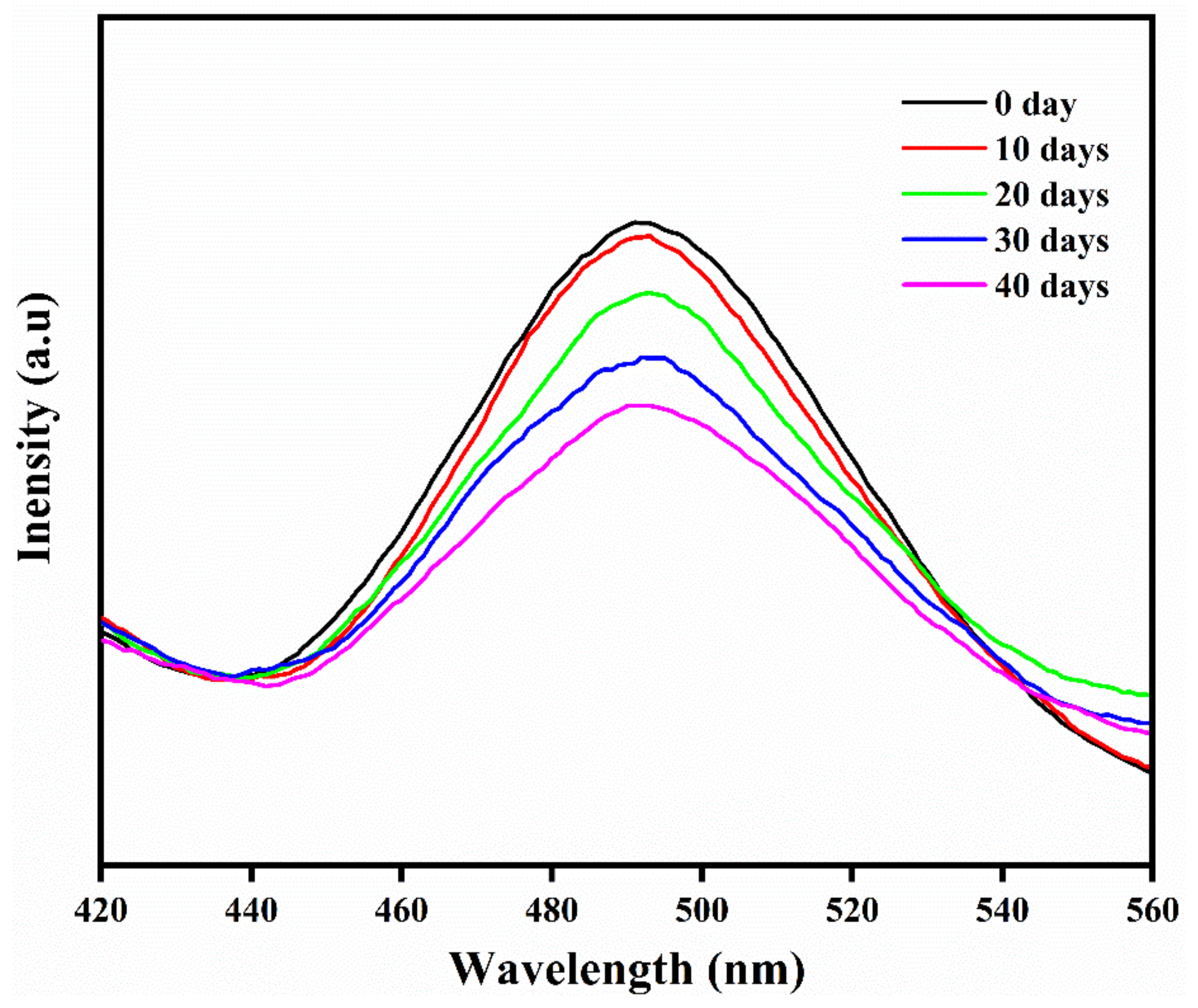
| Material | Tc (°C) | Tm (°C) | ΔHm (J/g) | Xc (%) |
|---|---|---|---|---|
| HDPE | 111.1 | 134.4 | 190.2 | 64.9 |
| HDPE/1AG1 | 110.4 | 135.0 | 181.4 | 61.9 |
| HDPE/3AG1 | 111.4 | 134.1 | 173.6 | 59.2 |
| HDPE/5AG1 | 110.2 | 134.6 | 172.1 | 58.7 |
| HDPE/10AG1 | 110.0 | 135.0 | 163.1 | 55.7 |
| Material | Tc (°C) | Tm (°C) | ΔHm (J/g) | Xc (%) |
|---|---|---|---|---|
| HDPE | 111.1 | 134.4 | 190.2 | 64.9 |
| HDPE/1AG2 | 111.5 | 134.3 | 174.1 | 59.4 |
| HDPE/3AG2 | 110.1 | 135.4 | 160.4 | 54.7 |
| HDPE/5AG2 | 110.5 | 134.5 | 160.0 | 54.6 |
| HDPE/10AG2 | 110.6 | 134.3 | 154.1 | 52.6 |
| Material | Tensile Strength MPa | SD | Tensile Modulus GPa | Elongation % | SD |
|---|---|---|---|---|---|
| HDPE | 32.04 | 0.31 | 0.84 | 58.5 | 4.58 |
| HDPE-10days | 33.63 | 0.49 | 0.70 | 51.22 | 5.17 |
| HDPE/20days | 34.12 | 1.48 | 0.67 | 39.51 | 6.31 |
| HDPE/30days | 33.51 | 0.20 | 0.66 | 20.28 | 7.5 |
| HDPE/40 days | 32.1 | 0.63 | 0.64 | 18.82 | 3.1 |
| HDPE/3AG1 | 31.94 | 0.34 | 0.84 | 48.14 | 4.11 |
| HDPE/3AG1/10days | 34.41 | 0.32 | 0.82 | 40.12 | 3.12 |
| HDPE/3AG1/20days | 34.12 | 0.51 | 0.79 | 36.32 | 4.2 |
| HDPE/3AG1/30days | 33.51 | 0.27 | 0.77 | 15.66 | 3.02 |
| HDPE/3AG1/40days | 33.95 | 0.59 | 0.72 | 11.21 | 2.51 |
Publisher’s Note: MDPI stays neutral with regard to jurisdictional claims in published maps and institutional affiliations. |
© 2022 by the authors. Licensee MDPI, Basel, Switzerland. This article is an open access article distributed under the terms and conditions of the Creative Commons Attribution (CC BY) license (https://creativecommons.org/licenses/by/4.0/).
Share and Cite
Poulose, A.M.; Shaikh, H.; Anis, A.; Alhamidi, A.; Kumar, N.S.; Elnour, A.Y.; Al-Zahrani, S.M. Long Persistent Luminescent HDPE Composites with Strontium Aluminate and Their Phosphorescence, Thermal, Mechanical, and Rheological Characteristics. Materials 2022, 15, 1142. https://doi.org/10.3390/ma15031142
Poulose AM, Shaikh H, Anis A, Alhamidi A, Kumar NS, Elnour AY, Al-Zahrani SM. Long Persistent Luminescent HDPE Composites with Strontium Aluminate and Their Phosphorescence, Thermal, Mechanical, and Rheological Characteristics. Materials. 2022; 15(3):1142. https://doi.org/10.3390/ma15031142
Chicago/Turabian StylePoulose, Anesh Manjaly, Hamid Shaikh, Arfat Anis, Abdullah Alhamidi, Nadavala Siva Kumar, Ahmed Yagoub Elnour, and Saeed M. Al-Zahrani. 2022. "Long Persistent Luminescent HDPE Composites with Strontium Aluminate and Their Phosphorescence, Thermal, Mechanical, and Rheological Characteristics" Materials 15, no. 3: 1142. https://doi.org/10.3390/ma15031142
APA StylePoulose, A. M., Shaikh, H., Anis, A., Alhamidi, A., Kumar, N. S., Elnour, A. Y., & Al-Zahrani, S. M. (2022). Long Persistent Luminescent HDPE Composites with Strontium Aluminate and Their Phosphorescence, Thermal, Mechanical, and Rheological Characteristics. Materials, 15(3), 1142. https://doi.org/10.3390/ma15031142








